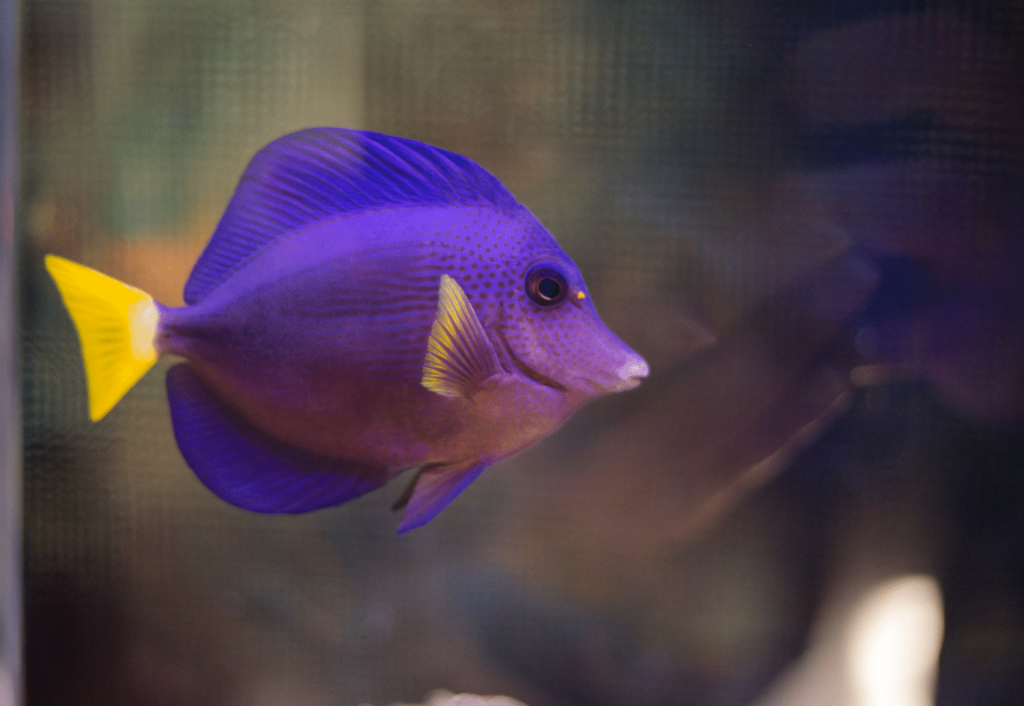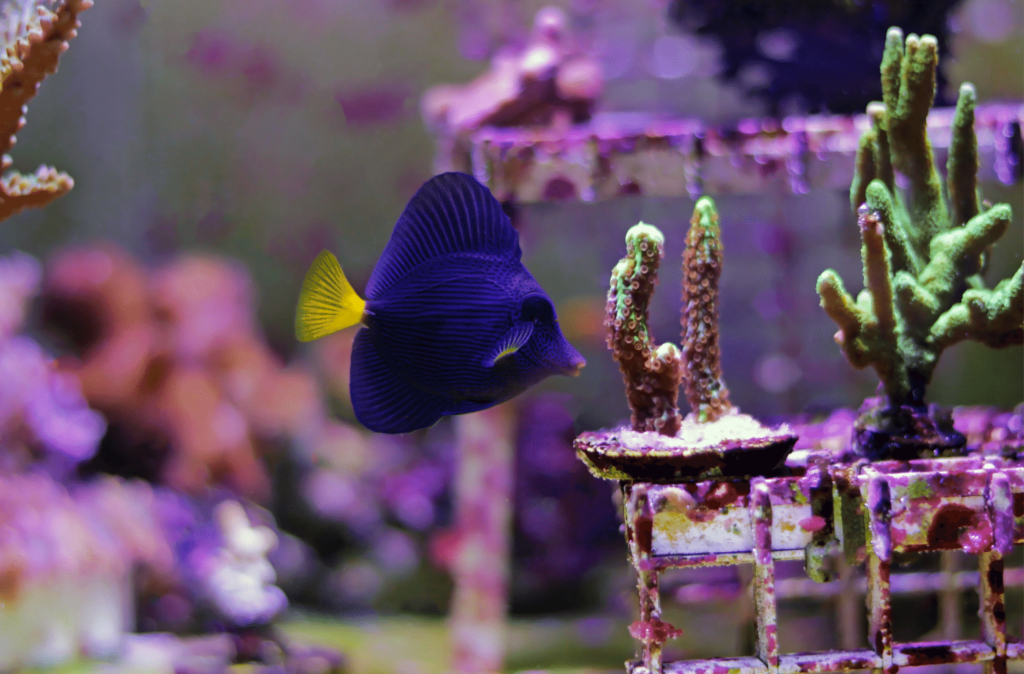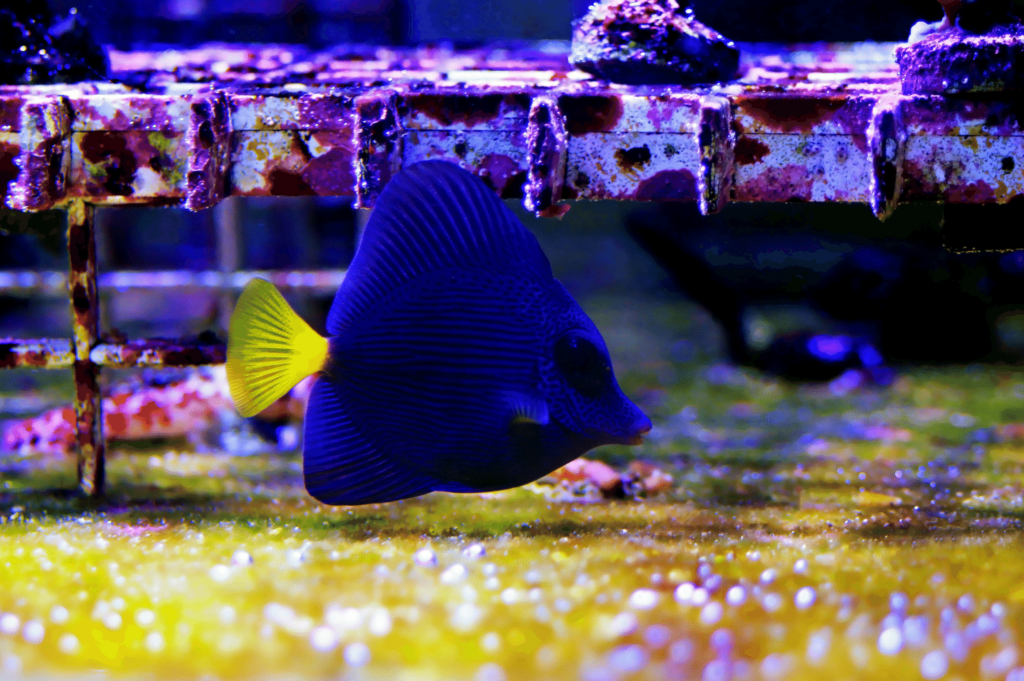Your cart is currently empty!

Feeding and Breeding: Essential Tips for Purple Tang Fish
Purple Tang fish, or Zebrasoma Xanthurum, is a vibrant and popular choice among marine aquarium enthusiasts. Native to the reefs of the Red Sea, these striking fish are admired for their beautiful coloration and active nature. However, ensuring their health and well-being requires proper feeding and breeding practices.
This blog post aims to provide detailed and accurate information for Purple Tang fish enthusiasts, helping them create the best environment for these magnificent creatures.
Understanding Purple Tang Fish

Purple Tangs are easily recognizable by their deep blue to purple bodies and vibrant yellow tails. Typically reaching about 8-10 inches in length, they are one of the more robust species within the tang family. Their streamlined bodies and sharp spines near the tail base are adapted for life among coral reefs and rocky substrates, where they dart in and out of crevices.
Purple Tangs are active swimmers and enjoy exploring their environment. They exhibit semi-aggressive behavior, especially toward other tangs or similarly shaped fish, which can lead to territorial disputes.
Therefore, providing ample space and hiding spots is essential to minimize aggression and stress. They are also known for their constant grazing, which helps to control algae growth in the aquarium.
Feeding Purple Tang Fish

In the wild, Purple Tangs feed on algae, providing them with essential nutrients. In captivity, it is crucial to replicate this diet to maintain their health. A well-balanced diet for Purple Tangs should include a variety of foods to ensure they receive all necessary nutrients, including vitamins, minerals, and fiber.
Types of Food
Commercial Fish Food Options
Several high-quality commercial fish foods are available that cater to the dietary needs of herbivorous fish like Purple Tangs. Look for products that contain a mix of marine algae, spirulina, and other plant-based ingredients. Some recommended brands include Ocean Nutrition’s Formula Two and New Life Spectrum AlgaeMax.
Homemade Food Recipes
Many enthusiasts also prepare homemade food mixes, which can be more economical and allow for customization. A simple recipe might include:
- Blended spinach
- Nori (dried seaweed)
- Broccoli
- Garlic (for its antiparasitic properties)
- Marine fish vitamin supplements
Blend these ingredients into a paste, spread thinly on a baking sheet, and freeze. Break off small pieces to feed your fish.
Importance of Variety
Feeding various foods helps prevent nutritional deficiencies and keeps your fish engaged. Rotate between different types of algae, vegetables, and commercial foods to ensure a balanced diet. Including occasional protein sources such as brine shrimp or mysis shrimp can also be beneficial.
Feeding Schedule and Techniques

Purple Tangs should be fed 2-3 times a day, with small portions they can consume within a few minutes. This frequent feeding mimics their natural grazing behavior and ensures they receive adequate nutrition throughout the day.
Portion Sizes
It’s essential not to overfeed, as excess food can lead to water quality issues. Offer enough food for the fish to eat within 2-3 minutes, and remove any uneaten food promptly to maintain water quality.
Tips for Ensuring All Fish Are Fed
If you have multiple fish in your tank, spread the food across different areas of the tank to ensure that they all get enough to eat. This strategy helps reduce competition and stress, allowing more timid fish to access food.
Breeding Purple Tang Fish
Breeding Purple Tangs in captivity is challenging, but not impossible. These fish have specific mating rituals, including courtship displays where the male shows off his colors and dances to attract the female. Observing these behaviors can provide insights into their readiness to breed.
Signs of Readiness to Breed
Signs that your Purple Tangs are ready to breed include increased aggression, pairing off, and frequent courtship displays. The male may become more territorial and display intensified coloration as he attempts to attract a mate.
Setting Up a Breeding Tank
- Tank Size and Setup Requirements: A separate breeding tank is recommended to provide a controlled environment. The tank should be at least 100 gallons to accommodate the fish’s size and swimming needs. Include plenty of live rock and hiding places to mimic their natural habitat and provide security.
- Ideal Water Conditions: Maintaining optimal water quality is crucial for successful breeding. Keep the temperature between 75-82°F, pH between 8.1-8.4, and salinity around 1.023-1.025. Regular water changes and consistent monitoring of water parameters are essential to create a stable breeding environment.
Breeding Process
- Courtship and Spawning: During courtship, the male will perform a series of displays to attract the female. If successful, the female will release eggs, which the male will fertilize. This usually occurs at dusk, when the lighting is subdued, mimicking natural conditions.
- Care of Eggs and Fry: After spawning, the eggs will float to the surface and require gentle water flow to keep them oxygenated. Providing a fine mesh net or breeding box is essential to protect the eggs from being eaten by other fish. Once hatched, the fry must be fed a diet of microscopic plankton and rotifers until they are large enough to eat larger food.
Challenges and Troubleshooting

Breeding purple tangs can be challenging, and challenges can include aggression between the breeding pair, poor egg viability, and difficulty raising fry. It is important to monitor the fish closely and intervene to separate aggressive individuals if necessary.
Solutions and Tips for Success
To increase your chances of success, provide optimal water conditions, a varied diet, and a stress-free environment. If aggression is an issue, consider separating the breeding pair until they are more accustomed to each other. Utilizing breeding boxes or partitions can also help manage aggression and protect the eggs and fry.
Health and Maintenance
Healthy Purple Tangs will display vibrant colors, active swimming behavior, and a healthy appetite. Regular observation is key to spotting any health issues early, such as changes in color, behavior, or eating habits.
Common Health Issues and Prevention
Common health problems include marine ich, fin rot, and nutritional deficiencies. Prevent these by maintaining excellent water quality, providing a balanced diet, and quarantining new fish before introducing them to the tank. Regularly inspect your fish for signs of illness and treat promptly if any symptoms arise.
Tank Maintenance
- Regular cleaning is essential to maintain water quality. Perform weekly water changes of 10-20%, clean algae from the glass, and vacuum the substrate to remove waste. Also, clean filters and check equipment to ensure they are functioning correctly.
- Use a high-quality filtration system and test water parameters regularly to ensure they remain within the optimal range. Address any imbalances promptly by adjusting water chemistry, increasing aeration, or performing additional water changes.
- Provide a stable environment with plenty of hiding spots, maintain consistent water parameters, and avoid sudden changes. Stress can weaken the immune system, making fish more susceptible to disease.
- If you notice aggressive behavior, rearrange the tank decorations to disrupt established territories or use tank dividers to temporarily separate aggressive fish. Introducing new fish carefully and monitoring interactions can also help manage aggression.
Expert Tips and Best Practices
- Advice from Seasoned Enthusiasts: Experienced Purple Tang keepers recommend patience, consistent care, and a focus on creating a natural environment. Observe your fish regularly and be proactive in addressing any issues that arise.
- Do’s and Don’ts: Do provide a varied diet and stable water conditions. Don’t overfeed or overcrowd the tank. Ensure all fish have access to food and shelter.
- Useful Resources and Further Reading: For more in-depth information, check out forums, books, and articles dedicated to marine fish care.
Dive Into Luxury and Conservation at Diamonds by Raymond Lee’s Aquarium!
Caring for Purple Tang fish can be a rewarding experience. You can observe their stunning colors and lively behavior. By following the tips and guidelines in this post, you can ensure your Purple Tangs thrive in a healthy and stimulating environment.
Have you ever wondered what it’s like to explore an underwater world while shopping for luxury items? Discover the magic of Diamonds by Raymond Lee’s aquarium today! Immerse yourself in a world of marine wonders and luxury at 2801 N Federal Hwy, Boca Raton, FL 33431. Come and explore the breathtaking beauty of our aquarium and make lasting memories with us.
